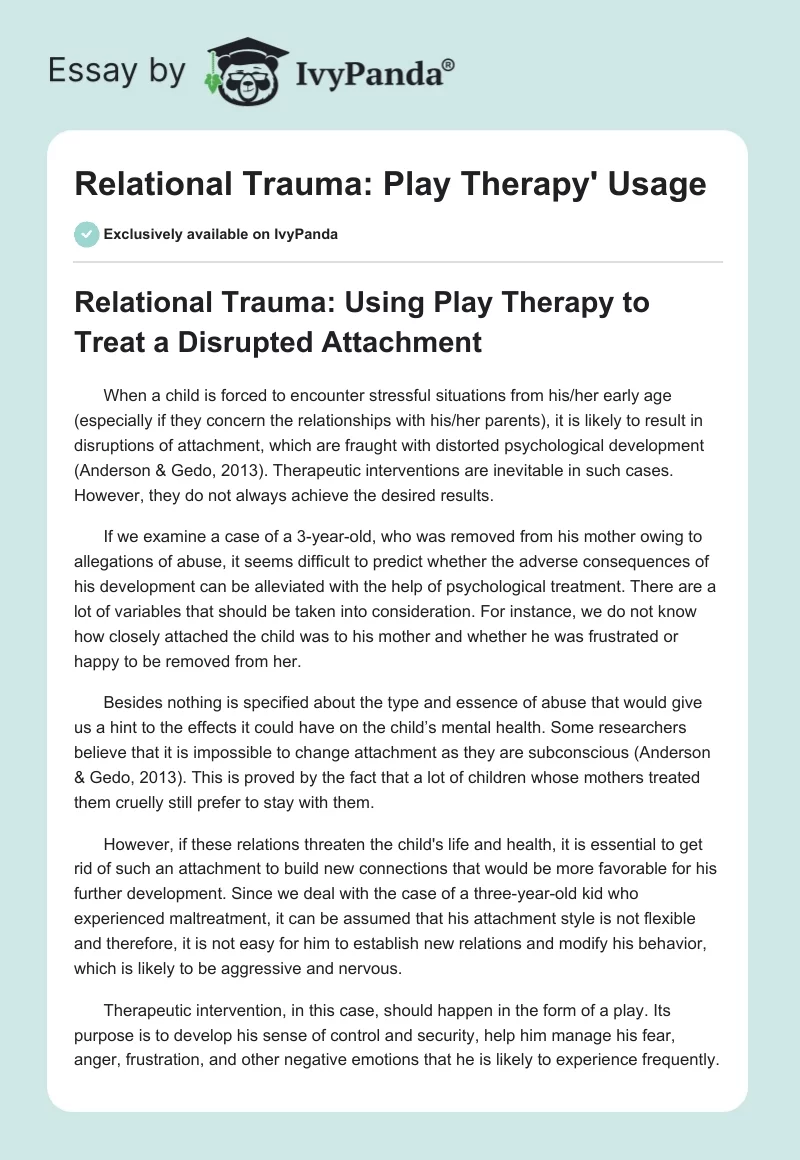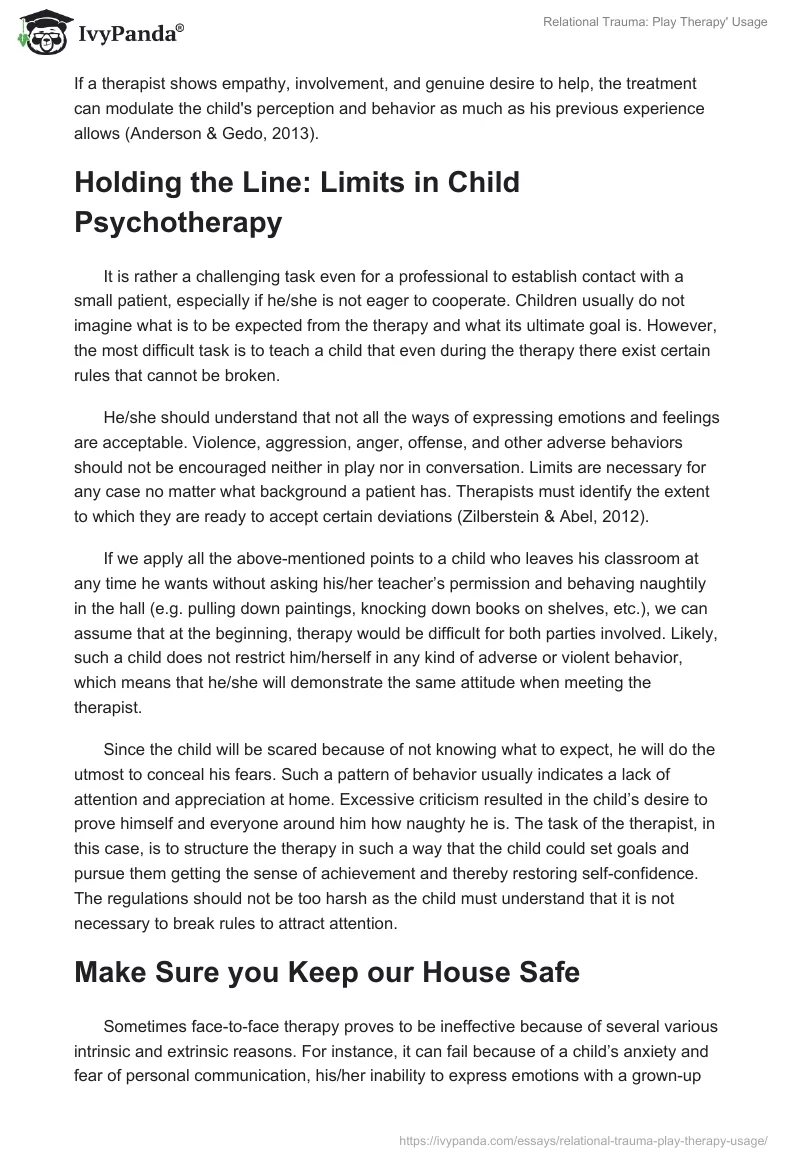Relational Trauma: Using Play Therapy to Treat a Disrupted Attachment
When a child is forced to encounter stressful situations from his/her early age (especially if they concern the relationships with his/her parents), it is likely to result in disruptions of attachment, which are fraught with distorted psychological development (Anderson & Gedo, 2013). Therapeutic interventions are inevitable in such cases. However, they do not always achieve the desired results.
If we examine a case of a 3-year-old, who was removed from his mother owing to allegations of abuse, it seems difficult to predict whether the adverse consequences of his development can be alleviated with the help of psychological treatment. There are a lot of variables that should be taken into consideration. For instance, we do not know how closely attached the child was to his mother and whether he was frustrated or happy to be removed from her.
Besides nothing is specified about the type and essence of abuse that would give us a hint to the effects it could have on the child’s mental health. Some researchers believe that it is impossible to change attachment as they are subconscious (Anderson & Gedo, 2013). This is proved by the fact that a lot of children whose mothers treated them cruelly still prefer to stay with them.
However, if these relations threaten the child’s life and health, it is essential to get rid of such an attachment to build new connections that would be more favorable for his further development. Since we deal with the case of a three-year-old kid who experienced maltreatment, it can be assumed that his attachment style is not flexible and therefore, it is not easy for him to establish new relations and modify his behavior, which is likely to be aggressive and nervous.
Therapeutic intervention, in this case, should happen in the form of a play. Its purpose is to develop his sense of control and security, help him manage his fear, anger, frustration, and other negative emotions that he is likely to experience frequently. If a therapist shows empathy, involvement, and genuine desire to help, the treatment can modulate the child’s perception and behavior as much as his previous experience allows (Anderson & Gedo, 2013).
Holding the Line: Limits in Child Psychotherapy
It is rather a challenging task even for a professional to establish contact with a small patient, especially if he/she is not eager to cooperate. Children usually do not imagine what is to be expected from the therapy and what its ultimate goal is. However, the most difficult task is to teach a child that even during the therapy there exist certain rules that cannot be broken.
He/she should understand that not all the ways of expressing emotions and feelings are acceptable. Violence, aggression, anger, offense, and other adverse behaviors should not be encouraged neither in play nor in conversation. Limits are necessary for any case no matter what background a patient has. Therapists must identify the extent to which they are ready to accept certain deviations (Zilberstein & Abel, 2012).
If we apply all the above-mentioned points to a child who leaves his classroom at any time he wants without asking his/her teacher’s permission and behaving naughtily in the hall (e.g. pulling down paintings, knocking down books on shelves, etc.), we can assume that at the beginning, therapy would be difficult for both parties involved. Likely, such a child does not restrict him/herself in any kind of adverse or violent behavior, which means that he/she will demonstrate the same attitude when meeting the therapist.
Since the child will be scared because of not knowing what to expect, he will do the utmost to conceal his fears. Such a pattern of behavior usually indicates a lack of attention and appreciation at home. Excessive criticism resulted in the child’s desire to prove himself and everyone around him how naughty he is. The task of the therapist, in this case, is to structure the therapy in such a way that the child could set goals and pursue them getting the sense of achievement and thereby restoring self-confidence. The regulations should not be too harsh as the child must understand that it is not necessary to break rules to attract attention.
Make Sure you Keep our House Safe
Sometimes face-to-face therapy proves to be ineffective because of several various intrinsic and extrinsic reasons. For instance, it can fail because of a child’s anxiety and fear of personal communication, his/her inability to express emotions with a grown-up person, lack of self-reflection ability, etc. Besides, it is more difficult for children to transfer what they learn individually to community settings like kindergartens or schools. In a group, a child learns certain patterns of social behavior and draws parallels with other social contexts. Group therapy creates a feeling of belonging, and a child does not feel lonely and isolated (Devi & Fenn, 2012).
Thus, if we consider the advantages of a 14-year-old girl diagnosed with ADHD could gain in a group, the major one is a chance to feel a part of a small community. Children with learning disabilities are often subject to mockery and neglect. In most cases, they have very few opportunities to establish social contacts with other children. Moreover, being a part of a group that includes people with similar problems can give this teenage girl a feeling that there is nothing abnormal in her condition and she is not the only one who has to meet challenges. It also allows learning from other children’s mistakes and receive encouragement from them.
And When you Were a Child
When a child undergoes therapy, his/her parents often get involved in the process. In many cases (especially when it concerns teenagers), therapists suggest parents to recollect their own state of mind at the same age. Their experiences may reveal repetitive motives in their children’s behavior, projections, and other hidden psychological factors. Besides, a person’s background allows making a connection to his/her personality (Whitefield & Midgley, 2015).
In the case of a 15-year-old girl who was raped by her step-uncle, there are also a lot of dependent variables that should not be ignored during the therapy. First, it is important to understand if all other experiences from her childhood can be called positive. The relationships with the girl’s father and stepmother also play a very important role.
The therapist must understand who can be engaged in the course of treatment. If the atmosphere in the family is rather acceptable, it means that the shock can be mitigated by the parents’ support. If it is not, perhaps, the girl would achieve better results in a group as there she can discuss her experience with others without feeling ashamed.
It is crucial to understand that the future perceptions the girl will have of men and family largely depends on how well she will cope with the situation. Thus, the task of a therapist is to make her feel a detachment from this negative experience.
References
Anderson, S. M., & Gedo, P. M. (2013). Relational trauma: Using play therapy to treat a disrupted attachment. Bulletin of the Menninger Clinic, 77(3), 250-268.
Devi, A., & Fenn, E. (2012). ‘Make sure you keep our house safe!’ Thematic analysis of a children’s psychotherapy group. Journal of Child Psychotherapy, 38(3), 318-334.
Whitefield, C., & Midgley, N. (2015). ‘And when you were a child?’: How therapists working with parents alongside individual child psychotherapy bring the past into their work. Journal of Child Psychotherapy, 41(3), 272-292.
Zilberstein, K., & Abel, S. (2012). Holding the line: Limits in child psychotherapy. Journal of Infant, Child, and Adolescent Psychotherapy, 11(1), 21-31.


